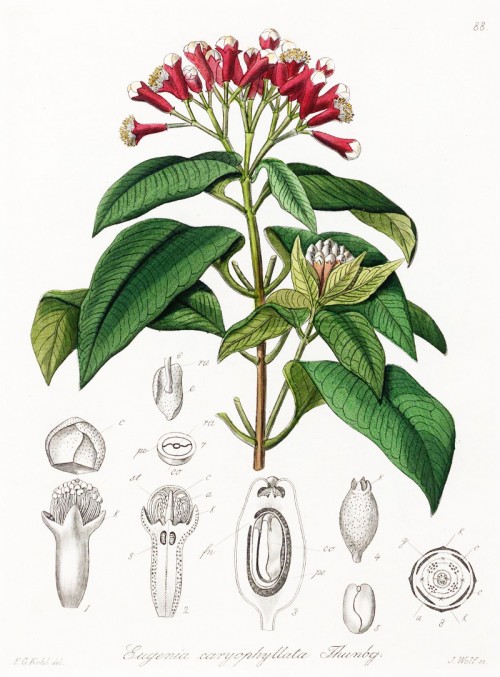Dies ist eine alte Version des Dokuments!
Myrtaceae - syn. Caryophyllus aromaticus L., Eugenia aromatica (L.) Baill., Eugenia caryophyllata Thunb., Jambosa caryophyllus (Sprengel) Niedenzu; cloves, Gewürznelkenbaum
Evergreen tree of Southeast Asia, cultivated in Southeast Asia, Zanzibar, Pemba and Madagascar. Up to 10-12m high, leaves elliptic-oblong, flowers with 4 white petals, turning pink. „The flower buds initially have a pale hue, gradually turn green, then transition to a bright red when ready for harvest. Cloves are harvested at 1.5–2.0 cm long, and consist of a long calyx that terminates in four spreading sepals, and four unopened petals that form a small central ball.“ http://en.wikipedia.org/wiki/Clove
„In clove essential oil, five compounds were identified as representing 98.5% of the total. The predominant compounds were eugenol (85.5%), β-caryophyllene (10.54%), α-humulene (3.12%), δ-cadinene (0.29%) and caryophyllene oxide (0.20%). Raina et al. 31 found 16 compounds, the main components being eugenol (94%) and β-caryophyllene (2.9%), while Zapata and Meireles reported that eugenol (58.62%), eugenyl acetate (19.58%), β-caryophyllene (19.87%) and α-humulene (1.60%) were the major constituents. Kwang and Shibamoto reported that eugenol and eugenyl acetate were the major constituents of clove essential oils made from buds which agree with the results obtained in this study, except in the case of eugenyl acetate, which was not found. The yield and quality of the essential oil depends on the part of the plant used, the predominant compounds in essential oil from clove stems being eugenol (83–92%), β-caryophyllene (4–12%), eugenyl acetate (0.5–4%), while the predominant compounds in the essential oil obtained from leaves are eugenol (80–92%), β-caryophyllene (4–17%) and eugenyl acetate (0.2–4%). The predominant compounds in the essential oil of clove buds are eugenol (75–87%), β-caryophyllene (2–7%) and eugenyl acetate (8–15%).“
[Chemical Composition of the Essential Oils Obtained From Some Spices Widely Used in Mediterranean Region. Manuel Viuda-Martos, Yolanda Ruíz-Navajas, Juana Fernández-López, José Angel Pérez-Álvarez, Acta Chim. Slov. 921 2007, 54, 921–926]
 eugenol (R=OH), eugenyl acetate (R=OAc)
eugenol (R=OH), eugenyl acetate (R=OAc)
Essential oil is made from flower buds, but leave and stem oil also contain eugenol and β-caryophyllene, but only about 1% eugenyl acetate. α-caryophyllene (humulene) is also present in the oil of all parts (bud 0.3-1.0%, leaf 1.3-2.1%, stem 0.2-1.3%)
„Clove bud oil (39 samples from Madagascar and 6 from Indonesia) were analyzed by GC and 10 constituents were identified and quantified. The major constituents of Madagascar and Indonesia bud oils were eugenol (77.50 and 79.87% respectively) and β–caryophyllene (4.06 and 6.91% respectively). Out of these two constituents which were common to Madagascar and Indonesia bud oil, significant difference was observed with respect to eugenyl acetate (16.01 vs 9.56% respectively).“ [G. Razafimamonjison, M. Jahiel, T. Duclos, et al., „Bud, leaf and stem essential oil composition of clove (Syzygium aromaticum L.) From
Indonesia, Madagascar and Zanzibar.” Natural Product Communications (sous presse), 2013“] http://afs4food.cirad.fr/content/download/4416/33602/version/1/file/Razafimamonjison,+essential+oil+of+clove+from+Indonesia,+Madagascar+and+Zanzibar..pdf

Kohl,F.G., Die officinellen Pflanzen der Pharmacopoea Germanica, t.88 (1891-1895)
http://plantgenera.org/species.php?id_species=992129
